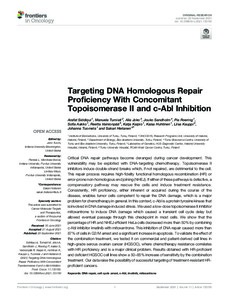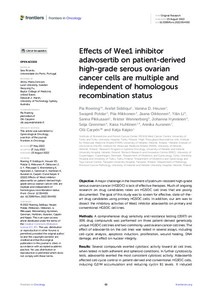Hae
Aineistot 1-5 / 5
A Subset of Secreted Proteins in Ascites Can Predict Platinum-Free Interval in Ovarian Cancer
<p>Simple Summary</p><p>Identifying proteins that correlate with better or worse outcomes may help to identify new treatment approaches for advanced high-grade serous ovarian cancer. Here, we utilize a machine learning ...
Targeting DNA Homologous Repair Proficiency With Concomitant Topoisomerase II and c-Abl Inhibition
<p>Critical DNA repair pathways become deranged during cancer development. This vulnerability may be exploited with DNA-targeting chemotherapy. Topoisomerase II inhibitors induce double-strand breaks which, if not repaired, ...
Effects of Wee1 inhibitor adavosertib on patient-derived high-grade serous ovarian cancer cells are multiple and independent of homologous recombination status
<p><b>Objective:</b> A major challenge in the treatment of platinum-resistant high-grade serous ovarian cancer (HGSOC) is lack of effective therapies. Much of ongoing research on drug candidates relies on HGSOC cell lines ...
PRISM: Recovering cell type specific expression profiles from individual composite RNA-seq samples
<p><strong>Motivation: </strong>A major challenge in analyzing cancer patient transcriptomes is that the tumors are inherently heterogeneous and evolving. We analyzed 214 bulk RNA samples of a longitudinal, prospective ...
Longitudinal single-cell RNA-seq analysis reveals stress-promoted chemoresistance in metastatic ovarian cancer
Chemotherapy resistance is a critical contributor to cancer mortality and thus an urgent unmet challenge in oncology. To characterize chemotherapy resistance processes in high-grade serous ovarian cancer, we prospectively ...




